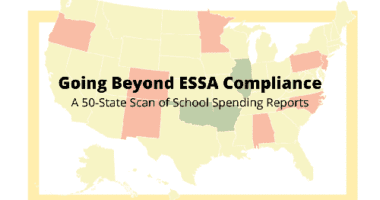From Numbers to Insight: Leveraging ESSA’s School Spending Requirement for Fair Funding
For decades, researchers have used federal data to show that within states, the districts with the most students from low-income backgrounds and the most students of color receive less funding than districts with the fewest students with these characteristics. And researchers have used other data to show that those same kinds of funding inequities exist within districts. But now, thanks to a new requirement in the Every Student Succeeds Act (ESSA), states must put this information in the hands of parents, advocates, and other community members who can use it to push for fair funding in their local schools.
To date, 22 states have already released at least some school-level spending data. Some states, like Texas and Louisiana, have been reporting this data for years, while others, like Massachusetts and Delaware, have added this data to their school report cards more recently. By the end of 2020, we expect all states to have released the spending data. That means that at least half of states are still grappling with decisions around how to report the data.
What makes good reporting?
As states work to meet this requirement, there are two critical components that they need to get right:
The first is calculation, which enables apples-to-apples comparisons of spending data across all schools and districts in a state.
The second is reporting, which can turn this data from yet another meaningless federal compliance exercise to a powerful tool that can help parents, advocates, school board members, and other community members understand whether the schools with the most need in their communities are getting the most funding to support those needs.
Ed Trust and our partners at Education Resource Strategies (with whom we have formed the Alliance for Resource Equity) have developed a set of five principles that can help guide states to go beyond mere compliance with ESSA and develop per-pupil spending reports that are meaningful, equity-oriented, and actionable. The principles highlight the additional data elements that states should report alongside financial data and the comparisons that states should provide to help stakeholders clearly see and make meaning of differences in spending.
Five principles for reporting equity-oriented school spending data
- Provide total per-pupil spending as well as a breakdown by source and location of spending
Displaying a clear total per-pupil spending amount shows stakeholders exactly how much each school or district spends and serves as a starting point for comparisons of spending across and within districts. Breaking down spending by source and location of spending (at the school or in the central office) can reveal where and why inequities may exist. - Provide contextual information to help interpret differences in spending
Including contextual information about the school or district — such as student need, school size, and program type — alongside financial data provides information to help make sense of differences in spending across schools and districts. - Provide comparative data on spending and need across districts and schools
Presenting meaningful spending comparisons to other schools and districts allows stakeholders to assess whether spending is differentiated to sufficiently meet various levels of student need. - Include additional information on how well resources are used to impact students’ experiences in schools
Reporting information about non-financial resources in the context of spending and need can help stakeholders make meaning of spending data and highlight where inequities exist — both in how much schools and districts spend and how well they use their resources to create high-quality learning experiences for all students. - Be clear and accessible
Creating accessible and transparent spending reports enables stakeholders to engage with the content and participate in equity-focused conversations about spending.
Since this is a new reporting requirement, there are few examples of what “good” looks like. Right now, there are two examples of promising practices: Illinois’ state report card and Ed Trust–New York’s school funding transparency tool that uses budget data released by the state. So, our partners at Education Resource Strategies have developed a draft guide of practices and effective visualizations to illustrate these principles. And in the coming months, Ed Trust will be rating states on how well per-pupil spending reports align with these principles to both identify promising and troubling trends across states and lift up bright spots of states that are reporting spending data well.
Our hope is that state advocates push their state leaders to incorporate these principles into their school-level spending reports, so that when parents, advocates, and other community members ask whether the schools in their district are receiving funds based on the needs of their students, the answers will be easy to find and understand in school and district report cards.
The Alliance for Resource Equity is a partnership between The Education Trust and Education Resource Strategies. Together, we are uniting advocates and education leaders to unlock excellence for every student through the equitable allocation and use of resources.










